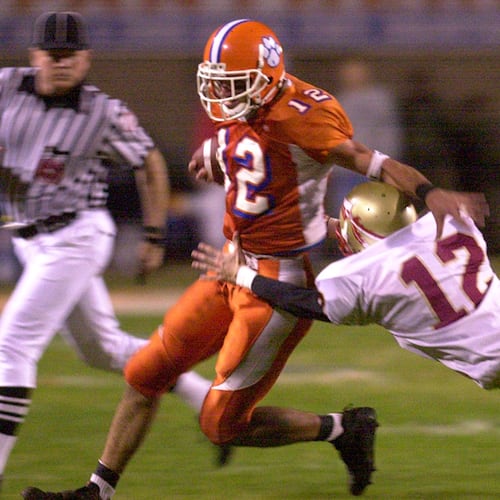Today’s interviewee is Adam Lindsey, a high school athletic director and a member of the Georgia High School Association’s competitive-balance research committee that came up with the proposal to reclassify schools beginning in 2026 using athletic success instead of enrollment size. Lindsey and others met with more than 200 athletic directors in the past year to educate them on how competitive-balance models work. GHSA executive director Tim Scott and former executive director Robin Hines have endorsed competitive-balance reclassification.
1. How did the idea of competitive-balance reclassification for Georgia high schools begin, and how has it evolved? “We originated the concept eight years ago and presented it then. It was developed to address the schools that, year after year, have no chance at postseason play. After researching the successes and failures of high school athletic programs in all classifications, it became clear that enrollment was not an effective indicator of a school’s ability to be successful. Our current system lumps schools together based on their enrollment, but when you compare that to the success each school has in their classification it shows that some of the smaller schools are having the most success and some of the largest schools are having no success. Seeing that drove home the fact that enrollment is not an effective indicator of a school’s ability to be successful in athletics. So, with that in mind, we started to really study the schools that are at the top and bottom of each classification, and for the most part those in each category remained in each category year to year. That is, the same schools at the top, the same schools at the bottom. We started asking ourselves if that consistency was due to a school knowing its athletic programs were going to be incapable of competing, which affects culture and morale, and knowing there’s no resolution in sight because they have to be where they are. Their enrollment numbers mandate it. Two schools, each with 3,000 students, have to compete with each other due to the current classification structure. One of the schools has just 150 student-athletes of its student population of 3,000 that compete in more than a dozen sports, while the other school has 1,500 student-athletes of its student population of 3,000 that compete in more than a dozen sports. The latter is advantageous in many ways but mainly in the ability it gives for specialization, singular focus, not competing with other programs for offseason training, etc. The school with 1,500 student-athletes mercy-rules the school with 150 student-athletes in every sport. The former is neither going away nor gaining anything competitively, and the latter isn’t getting better because its pool isn’t getting bigger, and five-star student-athletes don’t stick around schools that don’t win. So, each is stuck. Our current system of classifying schools is broken, and anyone that says anything different hasn’t sat through listening to more than 60 schools appeal their placement. Some appeals get approved, some get denied, but there’s commonality in that there’s no real rationale as to why those decisions are made. The Competitive Balance Reclass Model, among other things, takes the aforementioned decision-making out of it. Where your school is placed, and thus the teams your school is competing with, is a direct result of your results, of how our student-athletes perform on the field.”
2. Why is this model better than what the GHSA currently uses? “We have always thought that Georgia has the best athletics in the country, performed by the best student-athletes across the board, from metro Atlanta to Bainbridge. That gets lost, though, when half the football games on Friday night have running clocks in the fourth quarter, or when the same schools win region and state championships year in and year out, or when the same schools haven’t won more than four softball games since their program started. We want the most competitive games week in and week out, regardless of school size. We want to give that to all schools, year in and year out, regardless of size. We want to provide the opportunity to compete instead of continuing to see a number of our schools be mired in the ability to just show up to the competition. Go back to what having competitive athletic programs does for a school’s culture and morale but take it one step further and say a community’s culture and morale. Now take it to the biggest step: The ability to actually compete breeds competitiveness, and competitiveness breeds the desire to meet one’s full potential. The Competitive Balance Reclass Model is a good thing because it will, when all is said and done, bring out the best in teams, bring out the best in our student-athletes, and bring out the best in our communities.” [According to Georgia High School Football Daily research, the average victory margin for region football games last season was 25.7 points. The final victory margin was 30 points or more in 40.1% of the 1,101 region games. The actual number of running-clock games, reached when a team leads by 30 at the start of the fourth quarter, was higher because the 40.1% does not include running-clock games that ended with margins of less than 30 points.]
3. Your competitive-balance plan would put smaller private schools back playing with public schools for the same state championships. Currently there is a Class 3A-A private-only playoff division. What do you say to the smaller public schools who are opposed to playing with private schools? “It isn’t just 6A and 5A where the top teams stay the top teams and the bottom teams stay the bottom teams. The same names are at the top and bottom regardless of classification. If the smaller schools see that there is a plan to both deal with the schools consistently dominating, and ensure or uplift their ability to compete, no persuasion should be necessary. The merit of the competitive balance proposal lies in the fact that it doesn’t matter what your school name is. It matters how well your school performs on the field of play. Our current system allows for the same schools to sit in the same classification and dominate year after year, not just win, but dominate. And it hasn’t mattered if base enrollment numbers towards classification change, moving schools up or down, the same schools dominate; it might be a little harder or a little easier, but it’s the same schools.”
4. Others say your plan would punish success or reward mediocrity. How would you address that criticism? “This is not about giving everyone a participation trophy, but it is trying to find a way to level the playing field for all schools in the state. It is about creating a competitive balance from the smallest private school to the biggest public school. For a school to move up, it has to earn it on the field of play. A school moving down means that school earned it on the field of play and has to earn moving back up. Our model eliminates the ability for the state duals champion in wrestling in the state’s highest classification to be suddenly thrown into competing with schools two classifications lower the following year because the enrollment numbers dictated that they had to. That move isn’t good for the team that has the ability to dominate or the teams they’ll be competing against. Complacency is just as toxic as low morale. This model will provide the opportunity for so many schools to finally experience success and hopefully take that experience and work to grow it.”
About the Author
Keep Reading
The Latest
Featured


